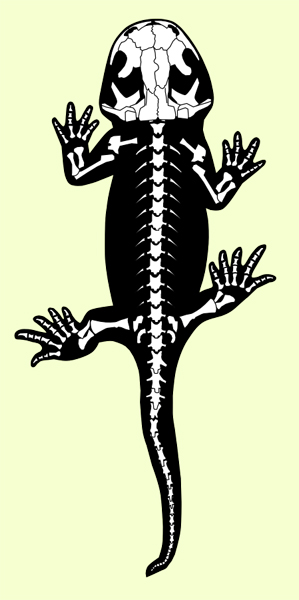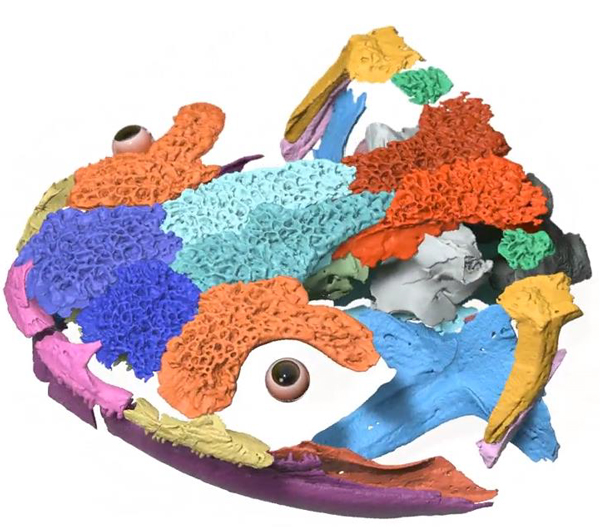A Scottish Stem Salamander Revealed by New Research
The fossils of an ancient amphibian found on the Isle of Skye (Scotland), are helping scientists to better understand the evolutionary development of salamanders. Writing in the academic journal “The Proceedings of the National Academy of Sciences” (PNAS), the researchers suggest that the fossils represent the oldest salamander fossil found to date in Europe.
A Scottish Stem Salamander

Marmorerpeton wakei
The stem Salamander genus Marmorerpeton was named and described in 1988, but detailed analysis of the Isle of Skye fossil material, including CT scans demonstrated that this was a new species, which has been named Marmorerpeton wakei. The species name honours the late Professor David Wake, who was a world-renowned authority on early salamander evolution.
Lead author of the study, Dr Marc Jones (University College London, Cell and Developmental Biology), commented:
“The fossil is definitely a salamander but unlike anything alive today. It highlights the importance of the fossil record for preserving combinations of anatomical features that do not exist in any living animal.”
The anatomical features of the new Scottish fossils of Marmorerpeton wakei were only revealed thanks to the detailed CT scans and subsequent computer-generated models. This scanning technology provides a powerful and non-destructive tool for revealing fine details on fossil bones. One specimen, collected in 2016, was found to be part of a specimen collected in 1971 but left undescribed until now.

Middle Jurassic Salamander
The fossils are thought to be around 166 million years old (Middle Jurassic) and although the Marmorerpeton genus was first described over 30 years ago, the material analysed in this new paper has permitted the researchers to build up a more complete picture of this 20-centimetre-long amphibian.
Marmorerpeton wakei had a wide but shallow frog-like head with powerful jaws and distinctive, prominent, bony projections behind its eyes. The skull roof bones show that it was ornamented like that of a crocodile or a temnospondyl, distinguishing it from extant salamanders. The limb bones and deep tail of Marmorerpeton wakei suggest this animal was aquatic, perhaps using its wide jaws to catch prey by suction feeding, similar to the lifestyle seen in the modern Hellbender salamander (Cryptobranchus alleganiensis) of North America.
The bony bumps behind the orbit are unusual and Dr Jones commented:
“The big bony projections behind the eye were a bit unexpected but smaller projections do exist in fossil salamanders from slightly younger rocks. Their purpose remains unknown.”
The early evolution of salamanders is poorly understood, their small and delicate bones are rarely preserved as fossils. This research also included a detailed survey of modern salamander anatomy which informed the subsequent analyses.
The Karaurus Genus
Several previous studies of Mesozoic salamanders have relied on fossils from the Late Jurassic, found in Kazakhstan, assigned to the genus Karaurus. As the Marmorerpeton fossils are older, they help to provide an improved understanding of how early salamanders evolved.

Senior-author Professor Susan Evans (University College London Cell and Developmental Biology), who first described Marmorerpeton in 1988 explained:
“The origin and early history of modern amphibian groups remains mysterious and new fossils like this one are key to developing a better understanding of amphibian evolution. In theory, the Skye salamander should give us a clue as to what the ancestors of modern salamanders looked like. However, it could be that they are a highly specialised off-shoot.”
To read an article from 2008 about a transitional fossil from the Early Permian that helped to define the evolutionary origins of modern amphibians: Amphibian Ancestry a Little Clearer Thanks to New Discovery.
Everything Dinosaur acknowledges the assistance of a media release from University College London in the compilation of this article.
Visit Everything Dinosaur’s award-winning website: Everything Dinosaur.
The scientific paper: “Middle Jurassic fossils document an early stage in salamander evolution” by Marc E. H. Jones, Roger B. J. Benson, Pavel Skutschas, Lucy Hill, Elsa Panciroli, Armin D. Schmitt, Stig A. Walsh and Susan E. Evans published in The Proceedings of the National Academy of Sciences (PNAS).
For models and replicas of prehistoric animals: Models and Replicas of Prehistoric Animals.

